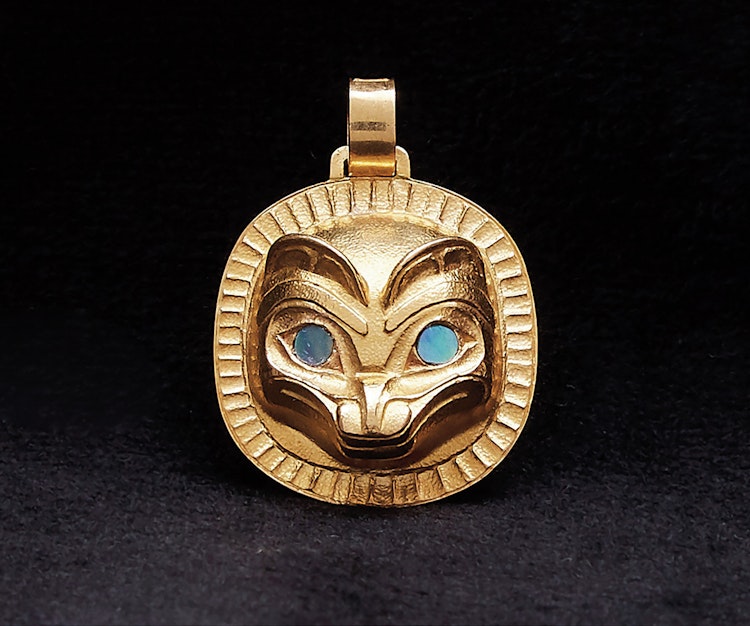Bear Cub Pendant (1990) by Bill Ronald Reid

Bill Reid
Bear Cub Pendant (1990)
22k gold pendant with abalone inlay and 18k gold clasp
hand signed, dated 1990 and numbered 2/15 on the reverse
1 x .75 ins ( 2.5 x 1.9 cms ) ( including clasp )
Auction Estimate: $30,000.00 - $50,000.00
Price Realized $47,200.00
Sale date: May 28th 2019
Acquired directly from the artist
Private Collection, Arizona
Bill Reid and Buschlen Mowatt Gallery, Bill Reid: All the Gallant Beasts and Monsters, Vancouver, 1992, page 28, illustrated page 30, listed page 41
Born to a Haida mother and a Scottish-American father, Reid was unaware of his native heritage until his teenage years. He was introduced to Haida culture through his maternal grandfather, and later inherited the artistic tools of his great-great-uncle Charles Edenshaw,
a renowned Haida artist. Reid had been studying European jewellery and engraving at the Ryerson Institute of Technology in the late 1940s.
He returned to Vancouver in 1951, and encountered two gold bracelets designed by Edenshaw at his grandfather’s funeral in 1954. Knowledge of the conventions of Haida art had all but dissolved completely, so Reid took it upon himself to study the gold and silver jewellery by Edenshaw in person at museums. He also copied images from reference books on Haida myths and argillite carvings in order to understand the fundamental dynamics of Haida art. Reid set up a basement workshop to apply the traditional jewellery-making techniques he had learned to traditional Haida designs.
Reid became accomplished in several media; he carved in silver, gold, wood and argillite and cast in bronze, referring to himself as “a maker of things” rather than an artist. He handcrafted personal objects of adornment that were adaptations from old crest designs or identity symbols, such as this delicate gold pendant with a finely detailed Haida bear cub mask design. In this striking work, Reid links his jewellery- making expertise to his heritage in a contemporary rendering.
Prominent Vancouver jeweller and friend of the artist, Toni Cavelti praises Reid’s artistic and cultural revitalization: “It has been stated that the designs of the Haida are perhaps the most beautiful, the most cohesive, the most harmonious of any of the early cultures. If that is so, then Bill Reid’s interpretation of it has brought it to its highest form.”
Although noted in the catalogue “Bill Reid: All the Gallant Beats and Monsters” as coming from an edition of 15 plus 1 Artist’s Proof, the pendant’s edition was never completed by the artist.
Share this item with your friends
Bill Ronald Reid
(1920 - 1998)
Born in Victoria, British Columbia, in 1920, Bill Reid was a Haida metalsmith, carver, and printmaker. Reid’s father was German-Scots-American, and his mother was Haida. He proclaimed that he was raised with little knowledge of his aboriginal ancestry, and it was not until adulthood that he realized his mother was Haida and he was related to generations of artists who lived on Haida Gwaii. Upon learning this, Reid contacted his maternal grandfather and his mother’s siblings to learn of their shared heritage.
Inspired by the Haida Gwaii, and the work of his maternal uncle, Charles Edenshaw, Reid was interested in pursuing goldsmithing as a career. He decided to attend the Ryerson Institute of Technology in Toronto from 1948-1950 to study goldsmithing. Reid apprenticed at the Platinum Art Company of Toronto after finishing the program at Ryerson. After university and his apprenticeship, Reid then moved from Toronto to Vancouver in 1951. Reid started his own jewelry workshop after moving to Vancouver. Here, he used his knowledge of both European and Haida jewelry found in museums, as well as his education in Toronto to make jewelry for his clients. Eventually, his knowledge of Haida culture and analyzation of Haida jewelry allowed Reid to become an expert of Haida design. His research linked traditional Haida culture to twentieth century art. In 1958, Reid was commissioned to re-create a section of a Haida village from the nineteenth century at the University of British Columbia. The project included two traditional Haida houses, seven totem poles, and other cedar carvings. Throughout the 1960s, Reid worked on commissions from institutions, corporations, and private individuals. Reid attended the Central School of Design in London in the late 1960s, and then settled in Montreal, where he began to create miniature sculptures.
However, Reid is most well-known for the large works he produced late in his life, such as The Raven and the First Men and Loo Taa. His projects helped create changes in the relationships between Haida and Canadian politics and culture. As an artist, Reid’s works have promoted northern design tradition, and bridged the generational divide in artists on the Northwest Coast. Not just an artist, however, Reid was a powerful public speaker and writer who argued against destructive ecological practices in British Columbia.
Literature Sources:
Joel Martineau, “Autoethnography and Material Culture: The Case of Bill Reid,” University of Hawai’i Press 24, no. 1, Winter 2001, pages 242-258.
Martine Reid, “Bill Reid,” Oxford University Press, Grove Art Online, 2003
We extend our thanks to Danie Klein, York University graduate student in art history, for writing and contributing this artist biography.

